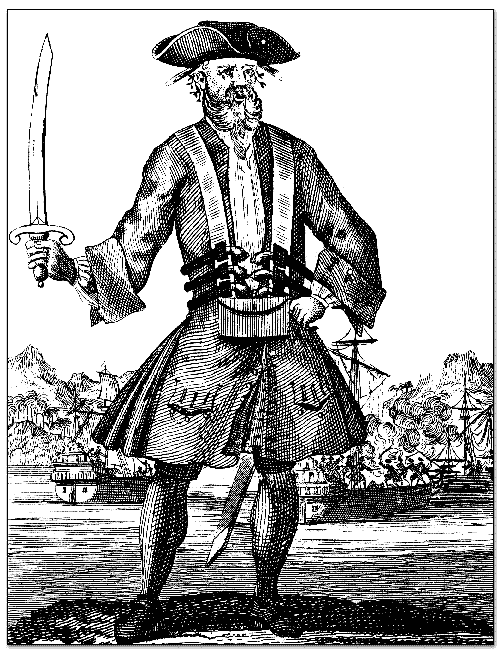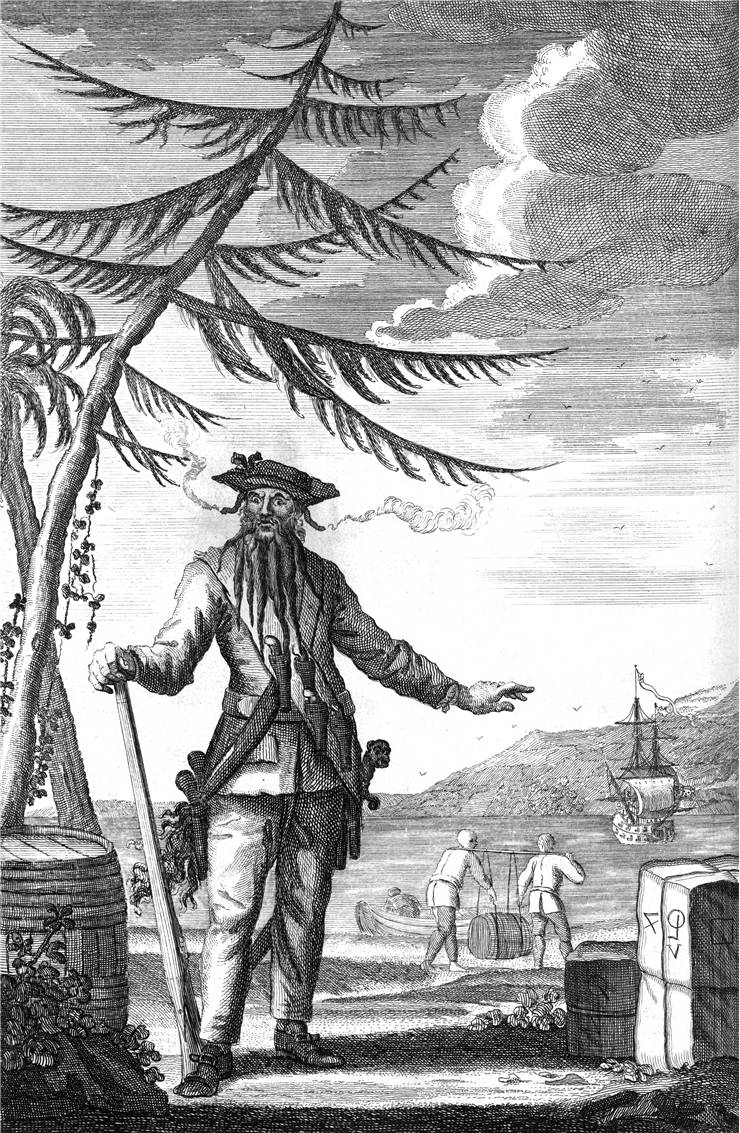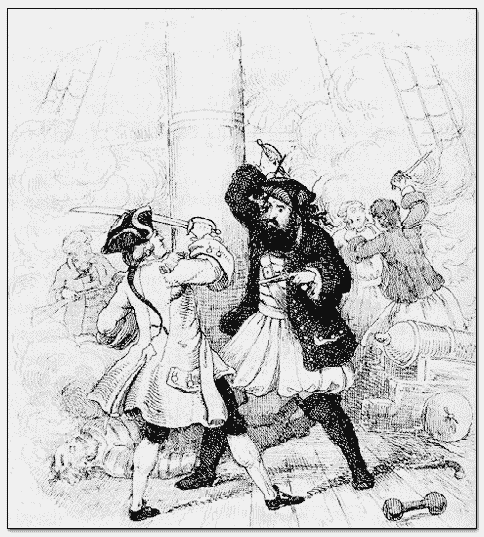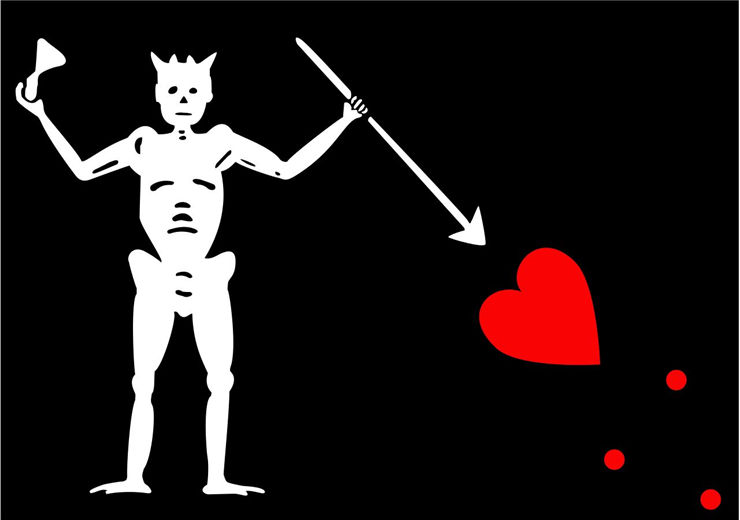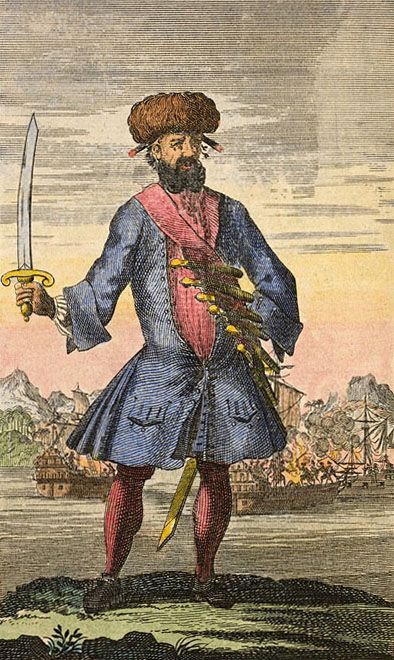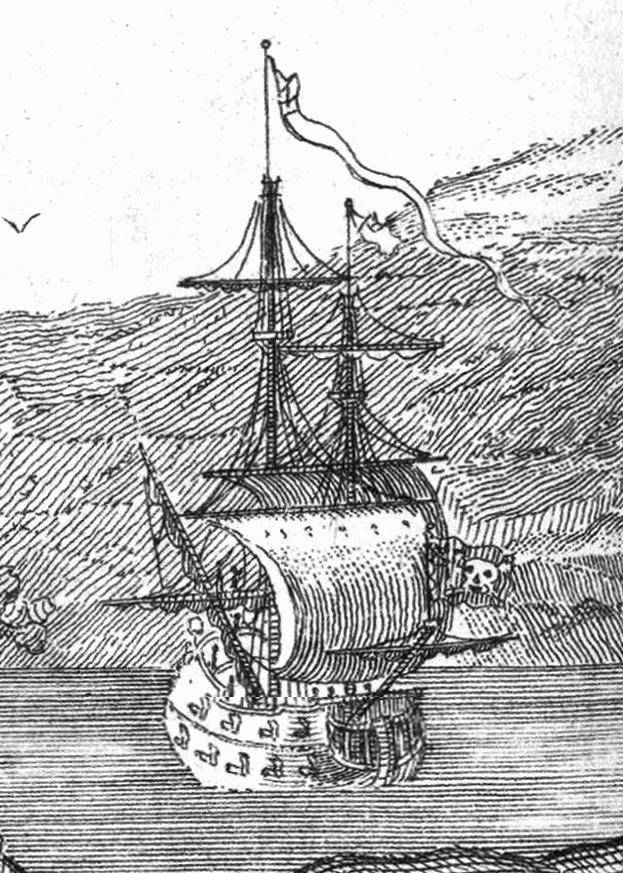Blackbeard - Pirate Edward Teach
Even though he was not the most successful, feared and hated sea-robber, legendary Blackbeard is probably not only the most famous pirate of the Caribbean, but also the most famous pirate captain of all time. As a notorious figure and a villain, he has been the main subject of many stories, books and movies in modern fiction.
In appearance, he was most notable and terrifying because of the long black beard which covered almost his whole face. For amusement, he used to separate it into the tails, each one tied with a differently colored ribbon. Speaking of his image, Teach was always wearing a sling with three pairs of pistols strung across his breast in addition to cutlass and few knives in his belt. An opposing crew often surrendered only by a sight of this seafaring pirate, although some rumors go that he was very generous with the people who cooperated with him. Intelligent and astute for a pirate, he was well educated, and he could read and write. He was also famous for his weakness for women. It is said that he had around 14 wives and that only his last marriage to 14-years-old Mary Ormond was legitimate.
His real name is not certain. Most likely it was Edward Drummond, but he always introduced himself as Edward Teach. However, he was the best known as Blackbeard. It is believed that he was born in Bristol around 1680. During his teen years, Blackbeard left England and took passage to the Caribbean. He served in Jamaica as a privateer during the War of Spanish Succession. After the war, he moved to New Providence in the Bahamas. There he worked as an ordinary crewman on the sloop commanded by the pirate and the ex-privateer, Captain Benjamin Hornigold.
Edward Teach learned about piracy during the bloody years of the War of the Spanish Succession
By learning the trade of piracy quickly, Blackbeard was promoted and awarded with his vessel and a small crew from his tutor. Soon, as he was sailing alongside Captain Hornigold and plundered many ships, Teach gained a bloodthirsty reputation. The "Concorde" was the last big capture of this duo. Nonetheless, it was the powerful 300-ton frigate armed with 26 guns. However, Hornigold decided to retire from a piracy and gave to Blackbeard the "Concorde". Horngold accepted the offer of general amnesty for pirates in the Caribbean Sea from Woodes Rogers, the governor of Bahamas. Teach upgraded the "Concorde" with 40 guns and renamed it to "Queen Anne's Revenge".
He continued to capture vessels in the Caribbean. His most epic victory was certainly the one in the sea-battle against the powerful warship, HMS "Scarborough", which brought even bigger reputation to the pirate captain. In January 1718, Teach sailed for Bathe Towne in North Carolina and found a new base in Ocracoke Islands. He was spending days robbing the passing ships. The nearby town's market was a perfect place for selling captured goods. Even the local Governor Eden was bribed so Blackbeard wasn't prosecuted for any of his crimes.
When the pirates sailed to Florida, Teach's crew encountered the sloop "Revenge", commanded by another famous pirate, Stede Bonnet. The two captains became friends, and they agreed to sail together as partners. However, soon after the agreement, Blackbeard realized that Bonnet was a poor leader and an uncompetitive pirate.
In that period, Blackbeard captured several more prize ships, and the sloop "Adventure" was added to his fleet. When the pirates left the Caribbean, the fleet consisted of not only four ships and over 300 pirates that he personally commanded, but he also had a big influence in his alliances that he made with other pirates. This alliance of pirates was not well organized or lasted for a long time, but its presence caused many disruptions in the Carribean seas. In May 1718, Teach anchored and laid prolonged siege near the harbor of Charles Town (now Charleston), South Carolina where he seized eight vessels, including the great ship “Crowley” which transported the group of prominent Charleston citizens. The highest ranking prisoner was Samuel Wragg, a member of the Council of the Province of Carolina. However, Teach’s crew was diseased and in a need of medicines rather than money. Blackbeard gave an ultimatum to Wragg, telling him that all the prisoners would be executed, their heads delivered to the Governor, and all captured ships burned if he would not receive medical supplies in exchange for the prisoners.
This brazen example of piracy near one of the big established harbor cities was one of the many reasons why Blackbeard managed to become such notorious figure in the early 18th century Caribbean and Eastern coast of the North American continent. After the city officials had failed to appear in the allotted time with the gathered medicine, Teach sailed his fleet near the city, causing the commotion and widespread panic in the citizens who started expecting sacking of the town. Thankfully, medicine arrived and captured citizens and merchants were released.
The siege of Charleston represents the height of the Edward Teach's popularity. By 1717, he has proven himself not just experienced ship captain, but a fierce leader who was prepared to embark on daring adventures and operate in the waters where he was not expected. His theatricality with prisoners and massive plunder he amassed made him one of the most commonly reported pirate in the print media of that age.
Unfortunately, just a few days after a siege of Charlestown when the pirates sailed to North Carolina, the "Queen Anne's Revenge" was lost as she ran aground in shallow waters at Beaufort Inlet. In that period, Teach planned to take a pardon like Hornigold. However, before that, he had committed a greedy treason. His intent was to rob Stede Bonnet. Blackbeard persuaded him to receive a pardon as well, but when he sailed for Bathe Town Teach marooned around 30 pirates on the island, stole all valuables from them and fled with the "Adventure". Later, Stede Bonnet rescued the marooned pirates, and in return, they agreed to obey his commands. Once again he took control of the "Revenge", which was left to him, as Blackbeard promised if Bonnet would accept amnesty.
Blackbeard tried to live honestly, but the call of the sea was too strong
Meanwhile, Teach returned to Bathe Towne, sold the entire booty, bought a house and was granted a pardon in June of 1718 from his "old friend", Governor Eden. He settled on Bath, Plum Point, North Carolina.
However, Blackbeard couldn't settle with an ordinary life. He was tired of pretending to be a prominent citizen, so after a few months, bloody pirate returned to the sea, but this time as a privateer. This sting lasted shortly because he soon started plundering innocent merchant ships near his base. Even though his activities were well covered, some local ship owners feared of Blackbeard and possible gathering of pirates that would be attracted by his influence. One of the examples of his “covert” acts of piracy happened when Teach managed to subdue crew of the two French merchant ships. He transferred all the crew from one ship to another and reported to Governor Eden that he has found “deserted” ship that was floating on the sea. Governor and the customs officer Tobias Knight marked the ship as derelict, shared its large cargo of sugar among themselves, and gave the remained of the cargo to Teach and his crew. Doubts about Teach's legitimacy as a privateer were increased when another famous pirate, Charles Vane visited Ocracoke Island to salute his old friend, bringing with himself several prominent figures of the pirate world such as John "Jack" Rackham (also known as Calico Jack), his partner in the eventual siege of Nassau in 1720.
By the time of the meet of pirate captains Teach and Vane, the Governor of Virginia Alexander Spotswood become too frustrated with the pirates who operated (both openly and covertly) near his area of influence. He was especially opposed toward the presence of former pirate crew members of Teach that moved to live in Virginia’s ports. He unveiled proclamation where pardoned pirates had to make themselves known to local authorities, to give up arms, and not be seen together in groups. He tried to convict former quartermaster of Queen Anne's Revenge William Howard, but he did not have legal ground to do so. The one good piece of a fortune he got was the location of the Teach, which prompted him to fund his personal pirate-hunting force. The two naval vessels, HMS "Pearl" and HMS "Lyme" commanded by the Lieutenant Robert Maynard and 57 soldiers traveled to Bath in hope of locating Teach.
After receiving reports that Teach was not in the city of Bath, on 21, November Maynard managed to find pirates that were anchored on the inner side of Ocracoke Island. Later it would be discovered that on that day Teach was not only busy celebrating a recent raid against some merchants, but he also sent more than 20 members of his pirate crew on shore. Not willing to risk anything, Maynard ordered the blockade of merchant shipping on entry to the sea inlet and posted lookouts that would notify him if Teach moved before he could organize the night attack. Just before dawn, Maynard entered the inlet with two of his sloops and a small “sounding” ship that went ahead and measured depth of the sea below them. Teach on the ship “Adventure” spotted incoming government ships, cut his anchor line, and opened fired on them with his cannons. After some maneuvering, Teach managed to achieve a devastating blow on the attackers, killing a third of their forces within seconds, including the captain Hyde of the “Ranger” and much of his officers. “Adventure” also received damage, and was unable to prevent ship of Lieutenant Maynard from closing in for a boarding maneuver. When the ships came close, pirates threw the grappling hook, threw smoke and explosive grenades, and boarded the ship expecting heavy resistance. However, Maynard was smarter, hiding the majority of his troops below decks. Surprise attack worked, and pirates quickly became overwhelmed. The reports of that battle speak of the one on one battle between Teach and Maynard, first with flintstocks (which missed) and then with swords. During that fight, Teach was severely wounded in the neck by one of the Maynard soldiers, which quickly led to his death from several soldiers who attacked him at once. After the battle, Maynard noted that Edward Teach was shot at least five times and cut around twenty. Head of the famous Blackbeard was hung on the mast of the ship so that reward for his death could be captured, while all but two the captured pirates from that raid were eventually hanged (one managed to convince the judge that he was just a guest of Blackbeard, while other that he was wounded by Teach from earlier and not present in the fight).
History remembers Blackbeard not only for how he lived, but also for how he died
The death of Blackbeard on November 22, 1718 caused several political issues between the Governor of Virginia Alexander Spotswood who funded this military expedition into the land which was under the control by Governor Eden. However, this event is is remembered today as one of the most important moments in the history of Golden Age of Piracy. While pirates of that age were viewed as “necessary evil” that was caused by the need for Privateers (who very often got official pardons for their deeds on the sea), modern historians viewed them as pure criminals while popular culture started to romanticized their exploits and lifestyle. The storied life of Edward Teach, his theatrics during pirate raids, and his death in battle became very popular in books and plays, eventually reaching films and other forms of modern media. The stories about his life became the stuff of lore, and even as early as 1724 stories about him, and his contemporary pirate figures became exaggerated and modified to serve better the sensational style of storytelling that audiences craved to read. Stories about him even reached the level of superstitious myths. For example, unexplained lights seen on the sea were often called "Teach's Light".
